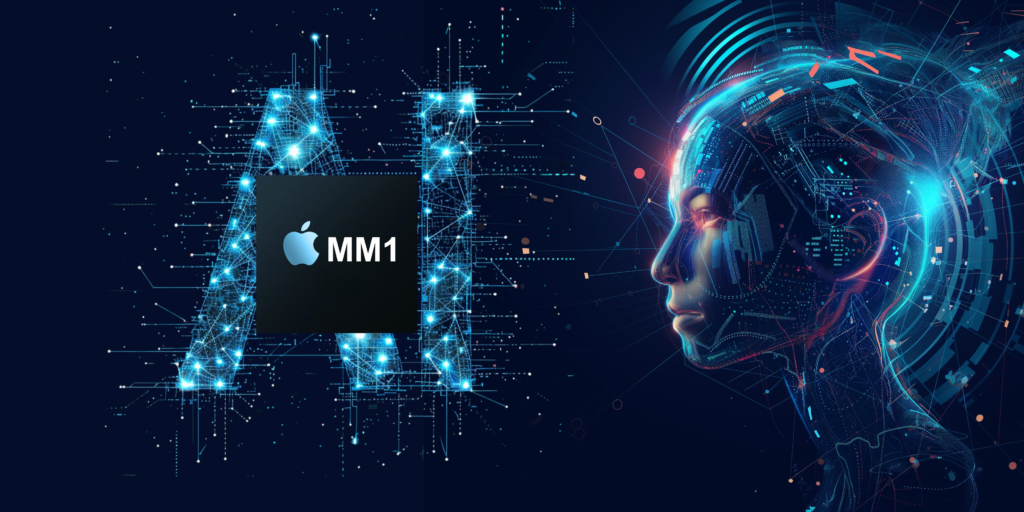Apple, a titan in the realm of technology, has long been synonymous with innovation and forward-thinking design. With a storied history of revolutionizing how we interact with technology, from the intuitive interfaces of the iPhone to the sleek efficiency of the MacBook, Apple’s dedication to pushing the boundaries of what’s possible has never waned.
In the rapidly evolving landscape of artificial intelligence, Apple has once again signalled its intent not just to participate but to lead. Despite leveraging Google’s Gemini to enhance iOS 18 with new AI features, Apple’s ambition stretches further with the development of its proprietary AI model, the MM1.
In a revealing paper, Apple has laid bare the framework of its approach towards the MM1 AI model, marking a significant step in its AI journey.
Authored by Joshua Hawkins on March 18, 2024, this document offers a glimpse into the innovative methodologies Apple plans to employ, setting a new precedent for AI’s capabilities in image captioning, visual question answering, and natural language inference.
As Apple ventures into the creation of its own AI model, the MM1, it stands at the precipice of a new era in technology, blending its rich heritage of design and engineering prowess with the boundless possibilities of artificial intelligence. This introduction serves as the doorway to understanding Apple’s ambitious project and its potential impact on the future of AI technology.
Apple’s MM1 AI Model
The MM1 AI model aims to redefine how machines understand and describe visual content. By generating accurate and contextually relevant captions for images, MM1 could revolutionize how users interact with their devices, making visual content more accessible and understandable.
MM1 is designed to comprehend and respond to questions about visual content. This capability signifies a leap towards more intuitive AI, capable of engaging in complex dialogues about the visual world, thus enhancing user experience in education, professional settings, and everyday use.
At the heart of MM1’s capabilities lies its advanced natural language inference. This feature allows the AI to understand and generate responses that are not only relevant but also context-aware, pushing the boundaries of how machines understand human language and interactions.
Apple’s ambition with the MM1 AI model is not merely to match existing standards but to set new benchmarks for accuracy in AI. By harnessing a diverse and rich dataset, Apple aims to fine-tune MM1’s capabilities to offer users an unparalleled level of interaction that feels natural, intuitive, and remarkably human-like.
This focus on accuracy is intended to ensure that whether it’s responding to queries, interpreting images, or engaging in dialogue, MM1’s performance is reliable, precise, and seamlessly integrated into the user’s digital life.
Apple’s development of the MM1 AI model is a clear indication of its vision for the future of technology. In this future, AI is omnipresent, not as a distant, impersonal force, but as a close, understanding companion that enhances every interaction with digital devices.
The MM1 AI model represents a significant milestone in Apple’s journey towards realizing this vision, promising a future where technology understands us as well as we understand it.
Making our interactions with digital devices more meaningful, personalized, and enriched. With the MM1 AI model, Apple is not just creating another AI; it is crafting the future of human-computer interaction.

Innovative Training Methods for MM1
Apple’s approach to the development of the MM1 AI model is distinguished not only by its ambitious goals but also by the innovative training methods it employs.
The company’s strategy is a blend of traditional and groundbreaking techniques designed to harness the full potential of AI through a comprehensive understanding of both linguistic and visual data.
This section explores the multifaceted training methodology Apple has adopted for MM1, highlighting how it sets the stage for a new era in AI capabilities.
At the core of Apple’s training methodology for MM1 is the use of a highly diverse dataset. This dataset includes:
By training MM1 on documents that interleave images with text, Apple aims to teach the model to understand the context and content of visual elements in conjunction with related textual information.
This approach mimics the way humans perceive multimedia content, enhancing the model’s ability to generate coherent and contextually relevant responses.
The use of image-caption pairs further refines MM1’s capability to accurately describe and interpret images. This training helps the model in mastering the art of generating precise captions for a wide range of images, improving its understanding of the relationship between visual content and language.
Despite the visual focus, the inclusion of text-only data ensures that MM1 does not lose sight of the intricacies of language. This aspect of the training dataset aids in developing the model’s natural language processing capabilities, allowing for more sophisticated inference and generation of textual content.
Apple’s MM1 model benefits from a training process that incorporates several types of data and training architectures.
This hybrid approach allows MM1 to learn from both linguistic and visual cues, enabling a more comprehensive understanding and generation of language based on a wide array of inputs.
By integrating different training architectures, Apple ensures that MM1 can adapt to various tasks, from simple caption generation to complex question answering and natural language inference.
The innovative training methods adopted for MM1 are designed to foster an AI that excels in understanding and generating language, not just as isolated text but as an integrated part of multimodal content.
This ability is crucial for applications ranging from enhanced accessibility features to creating more engaging and interactive AI assistants. By training MM1 with a combination of image-text documents, image-caption pairs, and text-only data, Apple is pushing the boundaries of what AI can achieve in terms of understanding the world around us and interacting with it in a meaningful way.
Apple’s unique approach to training the MM1 AI model exemplifies its commitment to innovation in the field of AI. By leveraging a diverse dataset and a hybrid of training architectures, Apple is not just aiming to enhance the capabilities of its own AI model but also to set new standards in AI training methodologies.
This approach underscores the tech giant’s vision of creating AI that is not only more accurate and reliable but also capable of understanding and engaging with humans more naturally and intuitively.
Through these innovative training methods, Apple is paving the way for a future where AI can seamlessly integrate into the fabric of our digital lives, enhancing our interactions with technology in unprecedented ways.
Combining Training Methods
Apple recognizes the value of standing on the shoulders of giants. By integrating tried-and-tested training methods from the broader AI development community with its proprietary techniques, Apple ensures that MM1 benefits from a rich heritage of AI research.
This includes utilizing large-scale datasets, advanced neural network architectures, and sophisticated training algorithms that have proven effective in the industry.
Apple diverges from the path by infusing these established methods with its unique datasets and training approaches. The interleaving of image-text documents, for example, offers MM1 insights into complex multimodal contexts that traditional models may not fully grasp.
This blend of external knowledge and internal innovation is critical to achieving the high levels of accuracy and versatility that Apple envisions for MM1.
One of Apple’s strategic advantages in the development of MM1 lies in the diversity of its training data and methodologies.
By exposing MM1 to a wide array of linguistic and visual stimuli, Apple aims to create an AI model that is not only adept at understanding and generating human-like text but is also capable of interpreting visual information with remarkable precision.
This multidimensional approach to training is expected to significantly boost MM1’s pre-training metrics, providing a solid foundation upon which further fine-tuning and specialization can occur.
The result is anticipated to be a highly competitive AI model capable of performing a broad spectrum of tasks, from enhancing user interaction with devices through natural language processing to advancing fields such as automated content creation and accessibility services.
Apple’s strategy highlights a broader trend in AI development: the convergence of different methodologies and the integration of diverse data types to achieve superior AI performance. By combining its own innovations with established training methods.
Apple not only enhances the capabilities of the MM1 model but also contributes to the evolution of AI research and development practices.
This collaborative and integrative approach reflects Apple’s recognition that the future of AI lies not in isolated advancements but in the synergistic combination of multiple disciplines and perspectives.
It’s a testament to Apple’s commitment to pushing the boundaries of what AI can achieve, ensuring that the MM1 AI model is not just a step forward for the company, but for the field of artificial intelligence as a whole.

Apple’s Unique Path
Apple’s foray into AI is built upon a foundation of design and engineering excellence that has marked its products and services for decades.
From the intuitive simplicity of the iPhone’s user interface to the sleek, functional design of the MacBook, Apple has always prioritized a seamless integration of technology into the lives of its users.
This same ethos is evident in the development of the MM1 AI model. Apple aims not just to create another AI system but to craft an AI that enhances user interaction through its understanding of both language and visual content, maintaining Apple’s hallmark of user-centric design.
Apple’s approach to AI is not just about developing new technologies but integrating them into a cohesive ecosystem that enhances the overall user experience.
With the MM1 AI model, Apple is poised to infuse AI capabilities across its range of products and services, from improving Siri’s responsiveness and context awareness to enhancing the Photos app with advanced image recognition and captioning features.
This integration strategy underscores Apple’s vision of a future where AI is not a standalone novelty but a core component of every interaction with technology, making devices smarter, more intuitive, and more personalized.
By charting its own course in the development of AI, Apple is not just following the trends but setting them. The company’s unique approach to training the MM1 AI model—with its focus on diverse datasets and hybrid training architectures—exemplifies how Apple is pioneering new directions in AI research and development.
This innovation extends beyond technical achievements, encompassing a broader vision for AI’s role in society, emphasizing privacy, security, and ethical considerations, which have always been at the forefront of Apple’s design philosophy.
In the competitive landscape of AI technology, where giants like Google and OpenAI have made significant strides, Apple’s entry with the MM1 AI model is a bold move.
Apple’s history of disruptive innovation suggests that its unique path in technology and AI has the potential to redefine the standards of AI performance and application. By leveraging its strengths in design, user experience, and seamless ecosystem integration.
Apple is well-positioned to carve out a significant presence in the AI domain, pushing the boundaries of what’s possible with artificial intelligence.
Apple’s unique path in technology and AI reflects its enduring commitment to innovation, design, and the user experience. With the development of the MM1 AI model, Apple is not just adding to its portfolio of technological achievements but is also shaping the future of AI.
As Apple continues to explore the vast potential of artificial intelligence, its unique approach could lead to advancements that not only enhance its product ecosystem but also transform the way we interact with technology on a daily basis.
In doing so, Apple reaffirms its position as a visionary leader, poised to influence the future of AI technology in profound and lasting ways.

Final Thoughts
As we conclude our exploration of Apple’s venture into artificial intelligence with the development of the MM1 AI model, it’s clear that the company is poised to make significant strides in the field.
Apple’s approach, marked by innovative training methods, a commitment to integrating AI across its ecosystem, and a vision that seeks to redefine user interaction with technology, underscores its potential to set new standards in AI performance and application.
- Innovation at the Core Apple’s MM1 AI model is built upon a foundation of innovation, leveraging diverse datasets and hybrid training architectures to enhance AI’s understanding and generation of language and visual content.
- Ecosystem Integration Apple aims to seamlessly integrate the MM1 AI model into its ecosystem, enhancing the user experience across devices and services with smarter, more intuitive AI capabilities.
- Setting New Standards By charting its own path in AI development, Apple is not just competing in the crowded field of AI technology but is poised to redefine what is possible, emphasizing user-centric design, privacy, and security.
- A Vision for the Future Apple’s unique approach to AI development reflects a broader vision for the technology’s role in society, aiming to create AI that enhances rather than replaces human capabilities, making technology more accessible, personalized, and engaging.
As Apple continues to develop and refine the MM1 AI model, the implications for the future of technology and AI are profound.
The integration of advanced AI capabilities across Apple’s product lineup promises to enhance daily interactions with technology, making devices not only more useful but also more intuitive and personalized.
Apple’s commitment to privacy and security in AI development sets an important precedent in the industry, highlighting the need for responsible innovation.
In a world where technology is increasingly intertwined with every aspect of our lives, Apple’s MM1 AI model represents more than just another advancement; it symbolizes a step towards a future where technology understands us better and enriches our lives in ways we have yet to imagine.
With its unique path in technology and AI, Apple is not just shaping the future of its own products but is contributing to the broader evolution of artificial intelligence as a tool for positive change in society.


